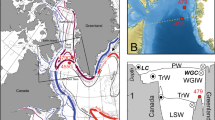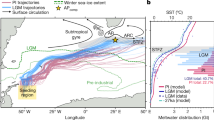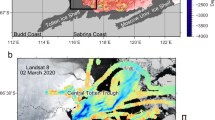Abstract
Abrupt centennial-to-millennial shifts in Northern Hemisphere climate during the last deglaciation are thought to have been triggered by the discharge of large volumes of meltwater and icebergs to the subpolar North Atlantic1. Here we show that meltwater and icebergs were also transported directly from the Laurentide ice margin to the subtropical North Atlantic in a narrow coastal current. We present high-resolution bathymetric data from south of Cape Hatteras showing numerous scours that we interpret as relict iceberg keel marks. This indicates that icebergs up to 300 m thick drifted to southern Florida (24.5° N). In simulations with an ocean circulation model, during deglaciation, fresh water and icebergs routinely reached as far south as 32.5° N, in a period of less than four months. The southernmost scours formed only during periods of high meltwater discharge from the Northern Hemisphere ice sheets. In the simulations, such extreme periods of meltwater release led to a reversal of the typically northward surface flow in the nearshore subtropical western North Atlantic. We therefore suggest that significant volumes of iceberg-laden meltwater routinely bypassed subpolar regions and spread across the subtropical North Atlantic.
This is a preview of subscription content, access via your institution
Access options
Subscribe to this journal
Receive 12 print issues and online access
$259.00 per year
only $21.58 per issue
Buy this article
- Purchase on Springer Link
- Instant access to full article PDF
Prices may be subject to local taxes which are calculated during checkout



Similar content being viewed by others
References
Broecker, W. S. Massive iceberg discharges as triggers for global climate change. Nature 372, 421–424 (1994).
Clark, P. U. et al. Freshwater forcing of abrupt climate change during the last glaciation. Science 293, 283–287 (2001).
Stea, R. R., Piper, D. J. W., Fader, G. B. J. & Boyd, R. Wisconsinan glacial and sea-level history of Maritime Canada and the adjacent continental shelf: A correlation of land and sea events. Geol. Soc. Am. Bull. 110, 821–845 (1998).
Hundert, T. & Piper, D. J. W. Late Quaternary sedimentation on the southwestern Scotian Slope, eastern Canada: Relationship to glaciation. Can. J. Earth Sci. 45, 267–285 (2008).
Todd, B. J. & Shaw, J. Laurentide Ice Sheet dynamics in the Bay of Fundy, Canada, revealed through multibeam sonar mapping of glacial landsystems. Quat. Sci. Rev. 58, 83–103 (2012).
Butman, B. et al. Shaded Relief, Sea Floor Topography, and Backscatter Intensity of Massachusetts Bay and the Stellwagen Bank Region Offshore of Boston, Massachusetts (U.S. Geological Survey, 2004).
Duncan, C. S. & Goff, J. A. Relict iceberg keel marks on the New Jersey outer shelf, southern Hudson apron. Geology 29, 411–414 (2001).
Goff, J. A. & Austin, J. A. Jr Seismic and bathymetric evidence for four different episodes of iceberg scouring on the New Jersey outer shelf: Possible correlation to Heinrich events. Mar. Geol. 266, 244–254 (2009).
Hill, J. C., Gayes, P. T., Driscoll, N. W., Johnstone, E. A. & Sedberry, G. R. Iceberg scours along the southern U. S. Atlantic margin. Geology 36, 447–450 (2008).
Çağatay, M., Keigwin, L., Okay, N., Sarı, E. & Algan, O. Variability of clay-mineral composition on Carolina Slope (NW Atlantic) during marine isotope stages 1–3 and its paleoceanographic significance. Mar. Geol. 189, 163–174 (2002).
Gil, I. M., Keigwin, L. D. & Abrantes, F. G. Deglacial diatom productivity and surface ocean properties over the Bermuda Rise, northeast Sargasso Sea. Paleoceanography 24, PA4101 (2009).
Lambeck, K. & Chappell, J. Sea level change through the last glacial cycle. Science 292, 679–686 (2001).
Dowdeswell, J. A., Maslin, M. A., Andrews, J. T. & McCave, I. N. Iceberg production, debris rafting, and the extent and thickness of Heinrich layers (H-1, H-2) in North Atlantic sediments. Geology 23, 301–304 (1995).
Metz, J. M., Dowdeswell, J. A. & Woodworth-Lynas, C. M. T. Sea-floor scour at the mouth of Hudson Strait by deep-keeled icebergs from the Laurentide Ice Sheet. Mar. Geol. 253, 149–159 (2008).
Chapman, D. C. & Beardsley, R. C. On the origin of shelf water on the Middle Atlantic Bight. J. Phys. Oceanogr. 19, 384–391 (1989).
Condron, A. & Winsor, P. A subtropical fate awaited freshwater discharged from glacial Lake Agassiz. Geophys. Res. Lett. 38, L03705 (2011).
Bard, E., Rostek, F., Turon, J-L. & Gendreau, S. Hydrological impact of Heinrich events in the subtropical Northeast Atlantic. Science 289, 1321–1324 (2000).
Chapman, M. R., Shackleton, N. J. & Duplessy, J-C. Sea surface temperature variability during the last glacial–interglacial cycle: Assessing the magnitude and pattern of climate change in the North Atlantic. Palaeogeogr. Palaeoclimatol. Palaeoecol. 157, 1–25 (2000).
Condron, A. & Winsor, P. Meltwater routing and the Younger Dryas. Proc. Natl Acad. Sci. USA 109, 19928–19933 (2012).
Spence, P., Saenko, O., Sijp, W. & England, M. North Atlantic climate response to Lake Agassiz drainage at coarse and ocean eddy-permitting resolutions. J. Clim. 26, 2651–2667 (2012).
Marshall, J., Adcroft, A., Hill, C., Perelman, L. & Heisey, C. A finite-volume, incompressible Navier Stokes model for studies of the ocean on parallel computers. J. Geophys. Res. 102, 5733–5752 (1997).
Dyke, A. S. et al. The Laurentide and Innuitian ice sheets during the Last Glacial Maximum. Quat. Sci. Rev. 21, 9–31 (2002).
Ehlers, J. & Gibbard, P. L. Quaternary Glaciations: Extent and Chronology (Elsevier, 2004).
Braconnot, P. et al. Evaluation of climate models using palaeoclimatic data. Nature Clim. Change 2, 417–424 (2012).
Teller, J. T. & Leverington, D. W. Glacial Lake Agassiz: A 5000 yr history of change and its relationship to the δ18O record of Greenland. GSA Bull. 116, 729–742 (2004).
Barber, D. C. et al. Forcing of the cold event of 8,200 years ago by catastrophic drainage of Laurentide lakes. Nature 400, 344–348 (1999).
Clarke, G. K. C., Leverington, D. W., Teller, J. T. & Dyke, A. S. Paleohydraulics of the last outburst flood from glacial Lake Agassiz and the 8200BP cold event. Quat. Sci. Rev. 23, 389–407 (2004).
Meissner, K. J. & Clark, P. U. Impact of floods versus routing events on the thermohaline circulation. Geophys. Res. Lett. 33, L15704 (2006).
Lentz, S. J. & Helfrich, K. R. Buoyant gravity currents along a sloping bottom in a rotating fluid. J. Fluid Mech. 464, 251–278 (2002).
Acknowledgements
Multibeam bathymetry data were obtained from the NOAA NGDC Multibeam Bathymetry data repository, as well as from D. Naar. S. Okano assisted with multibeam bathymetry data reprocessing. We thank L. Keigwin and T. Cronin for helpful comments and discussions on an earlier version of the manuscript and D. Menemenlis for assistance with the numerical model. This research was supported by the Office of Science (BER) US Department of Energy grant DE-FOA-0000452 and by National Science Foundation grant ARC-1204112. The numerical simulations used resources of the National Energy Research Scientific Computing Center, which is supported by the Office of Science of the US Department of Energy under Contract No. DE-AC02-05CH11231.
Author information
Authors and Affiliations
Contributions
J.C.H. was responsible for the seafloor data interpretation; A.C. performed the modelling studies. Both authors contributed to the discussion of results and preparation of the manuscript.
Corresponding author
Ethics declarations
Competing interests
The authors declare no competing financial interests.
Supplementary information
Supplementary Information
Supplementary Information (PDF 12475 kb)
Rights and permissions
About this article
Cite this article
Hill, J., Condron, A. Subtropical iceberg scours and meltwater routing in the deglacial western North Atlantic. Nature Geosci 7, 806–810 (2014). https://doi.org/10.1038/ngeo2267
Received:
Accepted:
Published:
Issue Date:
DOI: https://doi.org/10.1038/ngeo2267
This article is cited by
-
Into the Holocene, anatomy of the Younger Dryas cold reversal and preboreal oscillation
Scientific Reports (2024)
-
Submarine landslides triggered by iceberg collision with the seafloor
Nature Geoscience (2021)
-
Timing of iceberg scours and massive ice-rafting events in the subtropical North Atlantic
Nature Communications (2021)
-
Subsurface iceberg melt key to Greenland fjord freshwater budget
Nature Geoscience (2018)
-
A deep-sea community, including Lophelia pertusa, at unusually shallow depths in the western North Atlantic Ocean off northeastern Florida
Marine Biology (2015)



